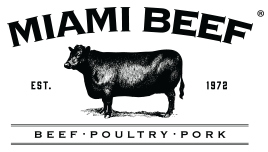

Red Carpet Luxury Burger Ideas for Restaurant Menus
The hamburger might be the most iconic official food of America. In every restaurant setting from fast-casual to five-star fine dining, you will find at least two different hamburgers on the menu. No matter what clientele you serve at your restaurant, it’s important to create some delicious options that exceed expectations, that can become a best-selling entrée. Because burger fans enjoy experiencing a quality hamburger, you can enhance their dining experience by innovating your own signature burgers. All it takes are some quality ingredients, and inspiration to create that uncommon masterpiece, to give diners something to Instagram and share with their family and friends.
Where do you start? We’ll share some tips for cultivating your own classic and gourmet burgers that are unique to your establishment. Miami Beef® has been the research and development team and wholesale resource for some of the best-known burgers across the United States. And we’re ready to help you develop your next sales leading burger entrée.
Upscale Your Ground Beef Blend with Kobe or Wagyu
Want to create a burger that is a cut above the rest? Start by changing the composition of the ground beef you start with. Standard chuck or lean ground beef provides good results, but if you really want to create an exceptional flavor, explore using a blend or 100% Kobe or Wagyu beef.
What is the big deal about Kobe beef? American style Kobe reaches back thousands of years, where the several varieties of black Japanese cattle were selected and exclusively bred as a delicacy. The desirable qualities of Kobe beef include a tender well marbled meat. The marbled fat that is trademark for American Style Kobe beef holds much of the rich beef flavors that are released during cooking.
The higher the quality of beef the more pronounced the flavor. If you are ready to innovate some luxury burger items for your menu, start with quality and uncommon ground beef and explore exciting toppings that enhance the rich taste of American Style Kobe or Wagyu.
Choosing the Right Bun and Bread Preparation
There is a lot of anticipation when a customer bites into a large juicy scratch burger, nestled in a fresh roll or bun. Create your luxury burger from the bun-up by being selective about the kind of flavor and presentation you are providing and choose an uncommon bun to differentiate your menu item from your competitors.
There is nothing more delicious than a fresh home baked burger bun. If your establishment has the capacity to bake your own buns, not only will you add the flavor of your gourmet burger, but you’ll set yourself apart with a signature bun. It’s not hard when you explore recipes that provide that perfect combination of a textured exterior and soft interior bread. Remember to stick to recipes that are designed for sandwiches with many toppings, to avoid sogginess.
Here are some scratch bun recipes to consider:
- Light Brioche Buns from Jane Sigal, NY Times Cooking.
- Gourmet Hamburger Buns by Stephen Shafer, Genius Kitchen.
- Authentic German Pretzel Buns by Meike Peters, Food Republic.
- Challah Burger Buns, The Iron Whisk.
Health conscious consumers want to make a better choice, when it comes to commercial bread and carbohydrate consumption. There are some great wholesale and retail providers that have created gluten free, and grain free burgers that are low in carbohydrates, and high in fiber. Once example is the KNOW Better Buns, which provide 16g of protein per bun, 12g of fiber and less than 4g of carbohydrate per serving.
Get Inspired by International Gourmet Burger Toppings
Quality beef burgers are the ultimate canvas for so many layered and sensational flavors. When you look at some of the most expensive gourmet burgers in the world, you can start to see how outrageous (and delicious) burger toppings can be!
Here are some of our favorite suggestions:
- fresh mustard greens
- grilled poblano peppers
- basted and grilled prawns (surf and turf!)
- Gruyere and fried egg
- Candied jalapenos
- Crabmeat and cocktail sauce
- Feta and cucumber sauce
- Chocolate coated bacon
- Pickled mushrooms
- Spicy beer mustard
- Brisket and BBQ sauce
Ready to innovate your next sales leading gourmet menu item? Talk to our hamburger experts at Miami Beef®. We have a full research and development team to help you customize the size, shape and seasonings in your burger.
We offer a variety of uncommon blends of ground beef for commercial food service customers, including:
- Wagyu
- American Style Kobe
- Beef and Chicken
- Pure Beef
- Pure Veal
- Black Angus
- Pure Turkey
- Beef and Soy blends
For scratch burger preparation, we provide our quality ground meat in four convenient sizes, from an 8 oz. log to 10 lb. bulk portions of fresh (never frozen) meat. When you are creating exciting new gourmet menu items, start with Miami Beef®.





